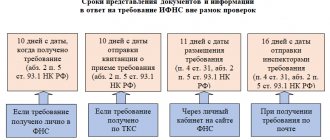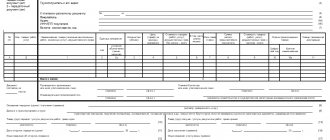Accounting is a system whose purpose is to collect, process and record all information that reflects the financial and economic activities of an enterprise. Accounting documents all transactions in a business, expressed in financial terms. Documentation is a legal requirement, according to which any entrepreneur is obliged to record all events in his business sphere. Accounting documents are used to record all activities of an enterprise. Primary accounting documents are especially important.
Primary documents
What it is? Primary accounting documents are a standard form, generated and filled out according to a specific template .
It is needed to complete all operations on the farm. It is these forms that confirm the implementation of various transactions (purchase, sale, lease, etc.), the inflow and outflow of the enterprise’s finances and other monetary transactions. The need to maintain primary accounting documents is determined by Federal Laws of the Russian Federation No. 129-FZ and No. 402-FZ. Requirements and samples are formed by state statistical bodies, and are confirmed by specific ministries.
Primary documentation in accounting is forms that record completed business transactions. Any entry in accounting or register is possible only if they are available. In essence, they are confirmation of all existing financial processes in the enterprise and the basis of relations with the tax office.
https://youtu.be/qC1N-kY-9CY
List of primary documents in accounting
Each company has the right to use any required forms of primary documentation. However, the most common list of primary accounting documents is represented by the following papers :
- Contracts. These documents contain specific terms of transactions, reflect the responsibility of the subjects of cooperation, record the financial circumstances of the transaction, etc. That is, the agreements must reflect all the basic conditions for the ongoing business transaction. An agreement is one of the first documents drawn up between the parties, on the basis of which their obligations are subsequently implemented;
- Accounts. Through this type of primary documentation, the buyer endorses his solvency, proving that he can pay for the product or service from the company that issued the invoice. Among other things, invoices often additionally note the nuances of various transactions, for example, a one-time discount or special services. If during the transaction one of the parties finds violations, then it will be able to legitimately demand compensation based on the invoice;
- Invoices. This type of primary documentation reflects a complete list of all products or raw materials transferred to the buyer. In most cases, 2 or more copies of invoices are drawn up for both parties to the transaction, as well as, for example, for the controlling authority;
- Acts. In particular, we are talking about a document proving the acceptance and transfer of certain works or services. Such an act is in fact the main evidence of the actual provision of a certain volume of services. In this case, the recipient must carefully check the fact with the information from the act, and only after that sign the document;
- Payslips. These are papers that record all the nuances associated with calculating employee salaries. Such primary documentation contains all the details of the provision of wages, including the calculation of additional payments, allowances, bonuses, vacation pay, sick leave, amounts of financial assistance, etc.;
- Acts in form OS-1. This act formalizes the event for the withdrawal or commissioning of a fixed asset;
- Cash documents. The most common cash documents at the moment are PKO and RKO, as well as a cash book. These papers record information regarding the financial aspect of the transaction.
Types of primary documents
What is included in this class of papers? All reports on any financial activities . Based on the characteristics and characteristics of the forms of primary documents, they are divided into:
By purpose:
- administrative (instructions);
- performing (statements).
By filling method:
- combined (advance report);
- strict (coupons or tickets).
By volume:
- primary (cash orders);
- summary (statements of expenses).
By type of operation:
- one-time (reports);
- accumulative (limit-fence cards).
By place of compilation:
- internal (invoices or advance reports);
- external (supplier invoices, payment requirements).
They can be standard (registration of transactions) or specialized (for highly specialized transactions).
What applies to primary documents? Their list is as follows:
- bank and cash statements;
- money orders;
- advance payment reports (with attached receipts from hotels, travel cards, receipts for stationery, etc.);
- sales receipts;
- invoices;
- accounts;
- working time records;
- statements.
All these forms are used by any company that carries out any financial activity.
Time sheet
This is interesting! What is a raider takeover?
What applies to accounting documents
Classification of accounting documents is carried out in the form of grouping according to individual characteristics. The main types and characteristics are listed in the table:
| Group sign | Documentation group | Short description | Examples |
| By final destination | Administrative and organizational | Contains separate orders of the company’s management on issues of its business activities | Such an accounting document is: · Check. · Order. · power of attorney |
| Executory and acquittal | Such documents are used to confirm the fact of commission (execution) of a business transaction | Samples are: · Invoices. · Cash orders. · TTN (waybills) | |
| Registration of accounting records | Such accounting documents are used as additional annexes to executive or administrative forms and cannot be drawn up as independent forms | · Accounting certificate. · Calculation sheet. · Management sheet. · Accounting | |
| Combined | Combines the features of administrative documents, executive and accounting documents | · Limit fence card. · Payroll | |
| By degree of generalization | Primary | The basis for making accounting entries are primary accounting documents | · Receipts and orders. · Acts. · Receipts. · Outfits. · Invoices. · Invoices |
| Summary or secondary registers | Summarize primary accounting data, compiled in accordance with primary documentation and used to control business operations | · Cash reports. · Expense reports. · Gazette. ·Calculations | |
| By data coverage method | One-time | Contains one business operation | · Cash order. · Employee's request for issuance of inventory materials |
| Summary or cumulative | Contains several homogeneous business operations that are repeated over a given period | · Outfits for a month or other period. · Limit cards for a week or a month | |
| By place of filling | Domestic | Filled out at this company | · Report card. · Invoices for the movement of goods and materials. · Acts. · Cash orders. · Vedomosti |
| External | Sourced from third parties | · Bank statements. · Invoices. · Acts. · Invoices | |
| By the number of accounting components | One-liners | Includes one item | · Outfits |
| Multiline | Includes several items | · Invoices. · Vedomosti |
Closing documents
Maintaining documentation, in addition to preparing primary and secondary forms, also implies the presence of closing forms . Closing documents are papers confirming the completion of a transaction by both partners and the full fulfillment of all obligations. These forms are recorded in the accounting department and filed so that they can be referred to later.
They are necessary for the transaction to be legally legal and final. And in order to avoid misunderstandings among partners, special attention is paid not only to carefully spelling out all obligations and recording them in the contract, but also to the correct execution of closing forms. For example, they describe in great detail the proposed checks and statements.
They are divided into different types depending on the type of transaction:
- Act;
- invoice;
- waybill (consignment note or goods bill).
It is important to know ! Only originals have legal force; copies cannot be used for legal actions.
If an error is made in such forms, this will not only negatively affect the reputation of the enterprise , but will also bring financial losses - the tax office imposes serious fines and additional taxes for such violations.
Invoice
Basic accounting documents and their purpose
Any accounting document represents a written basis for reflecting the fact of a business operation in the accounting of an enterprise. At the same time, the concept of accounting documents differs depending on its purpose. Each financial and economic transaction is subject to registration at the time of its completion. This action is the first stage of accounting. Then, based on the primary document compiled in accordance with established regulatory requirements, accounting registers are formed. And at the last stage, the data is summarized by filling out reports.
Accounting forms
Rules for filling and registration
It is very important to format everything correctly without errors or typos. To do this, you need to know what needs to be indicated in the document:
- Name;
- date of registration;
- name of the company (all participants in the transaction);
- current bank account and details;
- name of the transaction (quantitative composition and monetary value);
- Full names of responsible persons with their signatures;
- company seal.
There are also requirements for filling out forms:
- filled out using ballpoint pens, a computer or a typewriter;
- filled out only when planning an operation (rarely after its completion);
- All details must be indicated;
- internal forms are compiled at the enterprise, external forms are received from outside;
- Such documentation is maintained on standard printed templates.
Firms usually have ready-made samples of such forms and how to fill them out to simplify the process.
This is interesting! What types of contracts exist in civil law, table
Storage periods for primary accounting documents
Article 29 of the Accounting Law establishes only the general lifespan of accounting documents - at least five years. Order of the Ministry of Culture of Russia dated August 25, 2010 No. 558 (valid from September 30, 2011) approved the “List of standard management archival documents generated in the process of activities of state bodies, local governments and organizations, indicating storage periods” (hereinafter referred to as the List).
When applying the List, it should be taken into account that the established storage periods for documents should be counted not from the date of preparation of the document, but from January 1 of the following year.
Thus, the calculation of the storage period for cases completed in 2020 will begin on January 1, 2020.
Let us give the storage periods for certain types of accounting documents (see Table 2).
table 2
Storage periods for certain types of accounting documents
| Name of the accounting document | Shelf life | Rule of law |
| Cash, bank documents, acts of acceptance, delivery, write-off of property and inventory items, invoices, advance reports | At least five years, subject to completion of the inspection or revision and the absence of disputes and disagreements | Clause 1 of Art. 29 of the Law on Accounting, paragraph 362 of the List |
| Documents on accounts receivable and payable (certificates, reconciliation reports, correspondence, etc.) | At least five years | Item 379 of the List |
| Personal accounts of employees | At least 75 years old | Item 413 of the List |
| Executive documents | At least five years | Item 416 of the List |
| Liability agreements | At least five years after the dismissal of the financially responsible person | Item 457 of the List |
| Personal cards of employees | At least 75 years old | Item 658 of the List |
| Vacation schedules | At least a year | Item 693 of the List |
Separate storage periods are established for documents necessary for the calculation and payment of taxes (fees) - at least four years (subclause 8, clause 1, article 23, subclause 5, clause 3, article 24 of the Tax Code of the Russian Federation).
Some tax documents have special deadlines. First of all, this concerns primary documents that confirm the amount of the loss received (in case of its transfer to future periods), during the entire postponed period (clause 4 of Article 283, clause 7 of Article 346.18 of the Tax Code of the Russian Federation). Since the resulting loss, according to tax accounting rules, can be carried forward for ten years (clause 2 of Article 283 of the Tax Code of the Russian Federation), and the primary documents of the reporting year are stored for four years (subclause 8 of clause 1 of Article 23 of the Tax Code of the Russian Federation), the maximum period storage of “unprofitable” documents will be 14 years.
Despite the fact that a general storage period has been established for the storage of documents confirming the calculation of depreciation (four years), this period is calculated in a special manner (letter of the Ministry of Finance of Russia dated April 26, 2011 No. 03-03-06/1/270): four-year period storage of documents is counted from the end of depreciation on the fixed asset. For example, if depreciation is accrued for a fixed asset for the last time in July 2020, then the four-year tax storage period for documents will begin to flow from January 2020 and end in December 2020. But, since in accounting the primary documents related to the formation the original cost of a fixed asset must be stored for at least five years; in practice, the maximum storage period is used.
Table 3 shows the storage periods for certain types of tax documents.
Table 3
Storage periods for certain types of tax documents
| Name of tax document | Shelf life | Rule of Law |
| Invoices | At least four years, subject to completion of an inspection or audit (for example, tax) and the absence of disputes and disagreements | Subp. 8 clause 1 art. 23 Tax Code of the Russian Federation |
| Certificates of registration with tax authorities | Constantly | Item 381 of the List |
| Tax returns (calculations) of legal entities for all types of taxes | At least five years | Item 392 of the List |
| Documents confirming the amount of tax loss from previous years, the amount of which is carried forward to the future when calculating income tax | At least four years after the end of the tax period, the tax base based on the results of which was reduced by the amount of losses from previous years | Clause 4 of Art. 283 Tax Code of the Russian Federation |
Filling samples
Each primary form is filled out carefully and in accordance with all the rules. Invoices and payment documents are distinguished, the first are forms confirming the buyer’s readiness to make a transaction with the seller, and the second are reflecting the fulfillment of obligations by the parties. Forms of primary documents are filled out according to the sample as follows:
A sales receipt is confirmation of a transaction between a buyer and a seller regarding the purchase of a product or service. Typically, enterprises form it independently, but be sure to indicate:
- Name;
- information about the organization;
- type of transaction;
- natural and financial equivalent of the operation;
- Date of preparation;
- personal data of responsible persons and their signatures.
Sales receipt
A delivery note is a complete list of goods that are transferred to the buyer . It states:
- data of the shipper and recipient (name, legal address, telephone and details);
- type of activity according to OKDP for the seller;
- data of the supplier and payer (similarly with the consignee and sender);
- contract number and date;
- carrier data (if its services are used).
Consignment note
Payment order is a paper that is sent to the bank from the payer with an order to pay a certain amount of funds to the recipient to his account. It contains:
- sum;
- name of the enterprise (its tax identification number, current account and checkpoint);
- Full name of the payer and his bank;
- the recipient's bank and account;
- purpose of payment;
- date of registration;
- signatures.
Payment order
This is interesting! What is this according to the Civil Code of the Russian Federation: invalid, voidable and void transactions
An invoice is a form that is issued by a seller to its buyer after the sale of a product or service and is the basis for income tax reimbursement . It states:
- buyer and taxpayer information (name, address and tax identification number);
- information about the sender and recipient;
- names of goods, their quantity, cost and price;
- final price for excise duty;
- tax rate;
- place of production;
- declaration number.
Payment demand is a settlement form with the demand of the recoverer of funds from the debtor and the transfer of the specified amount to the given account as payment of the debt. It states:
- Date of preparation;
- amount of debt;
- terms of payment;
- name of the enterprise and its current account indicating the financial institution;
- payer bank;
- Full name of the payer;
- purpose of payment.
Samples of filling out all forms can be found at the tax office or on the Internet. It is very convenient to use a single template for each type of document to save time and minimize errors.
Payment request
Where can I find samples of unified primary documents?
The development and approval of forms for primary documents is the responsibility of Goskomstat (now Rosstat). Today, unified forms developed in the 90s of the last century continue to be used. Only settlement (payment) documents developed by the Bank of Russia have a relatively new edition - from 2012.
Such documents are called differently: acts, journals, invoices, statements, orders, books, instructions, calculations, powers of attorney, orders, etc. Using this table, you will find in which Resolution of the State Statistics Committee the unified forms of primary documents you need are published.
| Purpose of primary documents | Legal act |
| Accounting for personnel, working hours and wage calculations | Resolution of the State Statistics Committee of the Russian Federation dated January 5, 2004 N 1 |
| Accounting for cash transactions | Resolution of the State Statistics Committee of the Russian Federation dated August 18, 1998 N 88; Resolution of the State Statistics Committee of the Russian Federation dated 01.08.2001 N 55; Directive of the Bank of Russia dated July 30, 2014 N 3352-U |
| Accounting for settlements using cash registers | Resolution of the State Statistics Committee of the Russian Federation dated December 25, 1998 N 132 |
| Settlement (payment) documents | Regulations on the rules for transferring funds (approved by the Bank of Russia on June 19, 2012 N 383-P as amended on April 29, 2014) |
| Accounting for trade and catering operations | Resolution of the State Statistics Committee of the Russian Federation dated December 25, 1998 N 132 |
| Accounting for work in capital construction and repair and construction work | Resolution of the State Statistics Committee of the Russian Federation dated November 11, 1999 N 100 |
| Accounting for work in road transport | Resolution of the State Statistics Committee of the Russian Federation dated November 28, 1997 N 78 |
| Accounting for the operation of construction machines and mechanisms | Resolution of the State Statistics Committee of the Russian Federation dated November 28, 1997 N 78 |
| Accounting for fixed assets and intangible assets | Resolution of the State Statistics Committee of the Russian Federation dated January 21, 2003 N 7 |
| Accounting for low-value items | Resolution of the State Statistics Committee of the Russian Federation dated October 30, 1997 N 71a |
| Accounting for products and inventory items | Resolution of Rosstat dated 08/09/1999 N 66 |
| Materials accounting | Resolution of the State Statistics Committee of the Russian Federation dated October 30, 1997 N 71a |
| Accounting for inventory results | Resolution of the State Statistics Committee of the Russian Federation dated August 18, 1998 N 88 |
On our website you can obtain unified primary documents for personnel and cash transactions.
A strict reporting form (SRF) is also a primary document, but there are special requirements for it. The list of mandatory BSO details is wider than the list of ordinary primary documents, in particular, the TIN and the presence of a seal are required.
In the article “BSO: what should the strict reporting form be like?” you can find out in which cases it is necessary to use the unified form of this document, and when you can develop it yourself.
Corrections in primary documents
Since all papers are valuable to the enterprise, mistakes should not be made when filling them out. There are certain rules for correcting shortcomings :
- It is correct to rewrite the non-strict reporting form and destroy the damaged version, but strict reporting cannot be destroyed. Just cross it out diagonally in red and write “Canceled.”
- You can cross out the error with a thin line and enter the correct data at the top, and next to it write “Corrected Believe” with the signature of the responsible person and seal.
- The error cannot be completely shaded; it must be readable.
- If the amount of transactions performed is incorrectly indicated, it should be adjusted in the current or next quarter.
- You can correct errors in calculations with negative numbers.
In case of several errors, a form is attached to the papers stating that the corrected facts should be believed , and the responsible person is indicated. It is also necessary to affix the date to the corrections and the seal of the company.
Corrections in primary documents
This is interesting! We study a sample power of attorney to represent the interests of an organization
Features of drawing up primary documents in accounting
Despite the absence of a number of regulated forms, the legislation nevertheless provides a list of general rules that the drawn up primary documents must comply with. So, on the basis of Art. 9 Federal Law No. 402, the primary report must include the following information :
name of the paper and date of its execution;
- general information about the entity that compiled the document (company name);
- the essence of the business transaction being implemented, for the purpose of registration of which this paper is created;
- financial estimates relevant to the transaction;
- visas of responsible entities who are responsible for the implementation of the recorded business transaction.
If there are inaccuracies in the document (both in the semantic content and in the design area), then representatives of regulatory authorities may request re-issuance of the document, and also, in certain situations, impose a sanction on the originator.
General recommendations regarding the proper preparation of primary accounting documentation include the following positions::
- It is appropriate to fill in by hand, with a regular black or blue ballpoint pen. If registration takes place on a computer, you should print the document in standard black color;
- document execution must begin when the business procedure actually takes place. It is important to note that the execution of the primary document after the completion of the transaction is allowed, but in extreme cases;
- All calculation results must be written both in numbers and in words. It is necessary to minimize the possibility of dual interpretation and forgery. The visa of the responsible entity must be indicated next to each amount;
- You must fill out all points of the form. If some information is missing, then the line should not be left empty - it should be crossed out, depicting “Z”.
In cases where adjustments need to be made to the primary accounting documentation, the use of strokes and proofreaders is strictly prohibited. However, corrections are allowed in the following format :
- contour correction. This means crossing out incorrect information with a thin line, after which the correct information should be indicated next to it. It is also important to make a note “Corrected Believe”, indicating the date the adjustments were made and indicating the visa of the responsible entity. However, it is highly recommended not to correct information in payment and cash documents. It seems more appropriate to create a new document;
- registration of additional registration. This option is relevant in conditions where general transaction indicators are compiled with reduced data. In order not to create a new document, it is legal to make several additional accounting entries for missing funds so that in the end the operation is correct;
- reversal. An incorrect entry is corrected by entering negative indicators. All incorrectly entered data is duplicated in red, after which the relevant indicators are written down.
Primary documentation may be required both for internal document flow and for inspections by regulatory authorities. Correct execution reduces the risk of an illiterate outcome of each specific transaction.
Place and period of storage
After completion, processing and registration, the primary form must be stored at the enterprise for at least 5 years. It is kept in the accounting department in special rooms or cabinets (the papers must be completed chronologically, numbered and filed), and then moved to the archive. The transfer of papers, and, if necessary, their issuance occurs only with the permission and under the control of the chief accountant .
Papers are stored:
- 1 year – correspondence about reporting;
- 5 years – documentation of all financial transactions quarterly;
- 10 years – balance sheets and inventories for the year;
- 75 years – financial settlements with employees.
Important! All types of primary documents can be destroyed, even after the deadline has expired, only by decision of a special commission.
https://youtu.be/EksAUx08chM
What accounting documents should an LLC have?
It is impossible to list all types of mandatory documentation, since it is necessary to take into account the chosen tax regime, legal status and field of activity of the company. Any organization must have the following types of accounting documents:
- Accounting policy - the document is approved by the head of the company.
- Document flow schedule - the form is developed by the enterprise independently.
- Working chart of accounts - all accounts used in accounting are indicated, broken down by analytics.
- Accounting registers, including turnover, order journals, account analyzes, general ledger.
- Primary documents - on cash transactions and the movement of funds in bank accounts, invoices, acts, receipts, reports, statements, etc.
- Financial accounting, first of all, is Form 1 (balance sheet) and Form 2 (financial results report).
Note! Forms such as an act of acceptance and transfer of accounting documents, a sample can be found on the Internet, and a register of accounting documents when transferring cases, a sample is compiled in any form, required to be filled out when changing the organization’s accountant.











